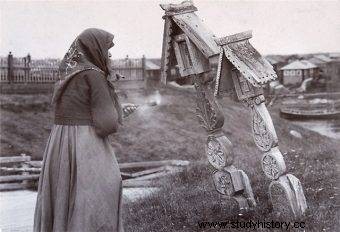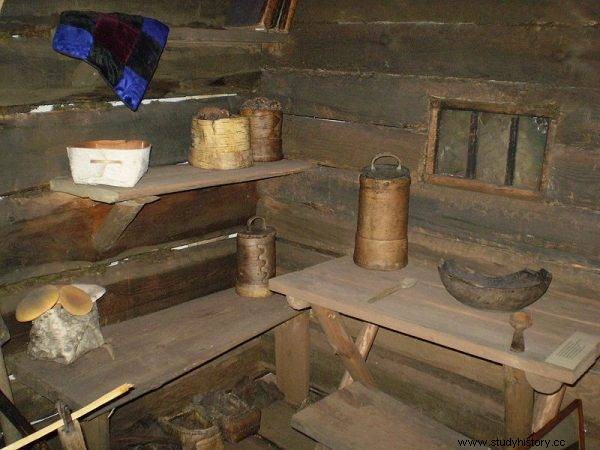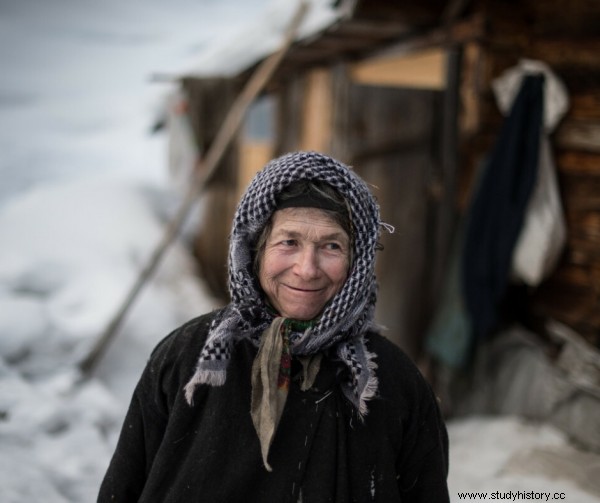In 1978, in the Russian taiga, a family was found that had lived far away from civilization for over 40 years - in conditions similar to those of the primitive peoples. Today, the last member of the family remains alive - 80-year-old Agafia, who did not want to return to civilization.
In June 1978, geologists searching for iron ore deposits in the upper Abakan River, while flying a helicopter over the endless taiga, noticed a vegetable garden and a hut on the side of a mountain. The presence of people in these uninhabited areas aroused their curiosity, so one sunny day they went to visit mysterious natives. As they approached the blackened hut, a barefoot old man dressed in a patched shirt and trousers came out to meet them.

The Lykovs were Old Believers (illustrative photo).
He invited them in. Two women were hiding there. One of them shouted, "This is the punishment for our sins!" The other was silent, but there was horror on her face. This is how the Łykow family was found - Old Believers who had been hiding in the taiga from the Soviet authorities for over four decades.
Escape from collectivization
Their extraordinary history began in the early 1930s. The young spouses, Karp Łykow and Akulina, and their children, Sawin and Natalia, lived in the village of Tisza on the Wielki Abakan River. When the collectivization of these areas began, they realized that the end of their peaceful lives had come. They decided to move to… taiga. They took with them, among others holy water (they diluted it with plain water as it waned), icons, prayer books and seeds of some plants. Soon they got used to the new conditions.
They built a hut among the trees. They planted a vegetable garden. They grew turnips, peas, rye, onions and hemp. In the meantime, more children were born to them - Agafia and Dmitry. The mainstay of the hermit family's nutrition was potatoes, which they stored in the cellar. But even there they broke down quickly so the Lykovs learned to dry them. They cut them into thin slices and on hot days spread them on large patches of birch bark or on the roof. The whole room was filled with boxes made of birch bark with potatoes prepared in this way.
The Lykovs enriched their skimpy menu with gifts of the forest - birch sap, pine nuts, wild onions, nettles, blueberries and mushrooms. They were fishing in summer and fall. They ate them raw, baked them on fire or dried them. Sometimes they managed to hunt elk or deer and then they had a real feast. Rye groats appeared on their table since holidays.
Akulin's mother taught the children to read and write. Instead of sheets, she used birch bark, and instead of ink - honeysuckle juice. When she dipped a pointed stick in it and began to "write" on the bark, pale blue letters appeared.
Unfortunately, in 1961, as a result of a crop failure, she died. Her body was too weakened by hard work.
Contact with civilization
The biggest drawback of this solitary life was ... the lack of salt. "Living without salt is a real torment," admitted Karp, the head of the family. When the geologists appeared in the hut, the Lykovs did not want to accept either bread or other food, but they freely took salt to use it to season their food.

Lykov family equipment in the Krasnoyarsk museum
Geologists visited the family during their delegations, and the Łykows gradually began to trust them. It turned out that the Old Believers had never heard of Lenin, Marx, Engels; they had no idea that the Great Patriotic War had swept through the Soviet Union and that the world was engulfed in a second global conflict . All their knowledge was based on the holy books, so when the family saw the planes, they concluded that they were "iron birds". Noticing the sputniks, they concluded that, "It was the stars who started walking in the sky."
Researchers regularly invited Old Believers to their camp, located 15 km from the hermits' home. Karp, however, stubbornly refused, explaining that "we must not." It is easy to imagine the scientists' surprise when one day they saw the Lykov family of 5 approaching their homes. Interestingly, the guests traveled all the way barefoot. First, the Lykovs and geologists had a nice chat, then the hosts offered them a meal.
The Old Believers refused:"We are not allowed to eat what you eat." They sat down separately. Their dinner consisted of homemade bread and nuts. For drinking:only water.
Agafia's loneliness
In the late fall of 1981, Savin, Dmitry, Agafia and Natalia suffered a severe cold that turned into pneumonia. They most likely contracted the infection from visiting geologists, and since they had been in solitary confinement almost all of their lives, their immune systems had not been sufficiently developed. Siblings except Agafia) refused medication and died.
Out of a family of six, only the father and daughter remained alive. Meanwhile, in 1982 Soviet journalists began to appear in the Lykovs' hut, thanks to which it became loud about the Old Believers from the taiga not only in the Soviet Union but all over the world. As for the attitude of Soviet citizens towards the Lykovs, some regarded them as parasites, while others admired their ability to survive in primitive conditions.

Agafia Łykowa was born in Siberia / East News
In February 1988, Karp died. Agafia, then forty-eight, refused to return to civilization. Although she visited her relatives several times, she did not stay warm among them - they differed in their views on religion. Nuns lived with her for some time, but due to the uneasy nature of the hostess, they returned to the convent. Agafia was also helped by the governor of the Kemerovo region, Aman Tuleyev, who ordered his subordinates to regularly provide the woman with food and medicine and provide medical assistance.
Currently Agafia is 80 years old and still lives in the taiga, because - in her opinion - living in the wilderness, far from the temptations of civilization, is the most appropriate from the point of view of spirituality.
Bibliography:
- Песков В. Таежный тупик . Москва 2007.
- Таежный тупик:как семья Лыковых смогла так долго прожить в изоляции, (accessed on November 21, 2020).
- Урушев Д.А. Русское староoбрядчество. Традиции, история, культура . Москва 2016.
